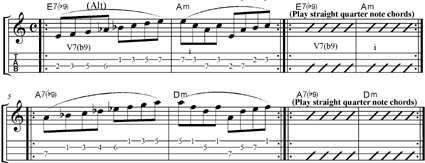« Improvisation: too many choices? |
Main
| Limiting your voicing. Three's company. »
 October 22, 2009 | Bridging Chord Melody October 22, 2009 | Bridging Chord Melody
One of our goals in our Mel Bay book project "Getting Into Jazz Mandolin" was to introduce chord melody style playing. The great Jethro Burns was a master studied by many mandolinists, and his ability to seamlessly slip in an out of chord and melody was a treat to the eye and ear. It's certainly an intimidating skill, even for the player adept at chords, and proficient at melody. It's that doing both at the same time thing that is so confounding.
Many get too worked up about even attempting it. You could start gently by becoming effective at playing 3rds and 6ths parallel to a melody. This isn't terribly hard to do up and down the fingerboard, but you are kind of limited to one scale, at least conceptually. Still, we are talking about a two-note chord, and that's a chord by any definition. Adding a 3rd and 4th voice is nice, but not always necessary.
Assuming you already have an arsenal of chord variations, you can also finger each chord, paying close attention where the notes of the melody are and voicing them so that the tune is heard, usually melody on top. It takes a little thinking and planning, but learn a few songs this way, it starts to get easier as you develop your own tricks. It is certainly colossal cerebral exercise, and not for the faint of heart.
Probably the best way to get down the path of Chord Melody technique is to get comfortable moving in and out of either. Looking for "Grips" or chord fingerings that strategically coincide is a skill you can master over time. Think of it as melody proficiency, side by side with chord voicing aptitude. We'd suggest starting with something simple like a couple measures of melody, followed by a couple more of comping chords. Get the melody in your fingers, but also figure out how your are going to chord the following measures with efficient chord movement.
This is an example out of the "Getting Into Jazz Mandolin" book:

You can take simple stretches of melody, a Real Book tune for example. Take something you are familiar with both comping and playing the melody, and try alternating between chords and melody. Try them in two measure increments. When you are comfortable with that, try alternating every measure. Later when you can do partial measures of each, you are there. You are playing Chord Melody!
Don't feel the obligation to do four-note chords. As you develop the skill, you'll be adding two-note chords as well, and the parallel 3rds and 6ths will be intermingled in there too, along with a host of trick double stops. Try to use as much of the first 12 frets as you can.
Don't be afraid to experiment. Your only limitation will be your own creativity.
Further:
The benefits of third position fingering
Grip #1
Playing musically: Part 2, play the chords
Chord Melody from Aaron Weinstein
Scratching the Surface of Chord Melody
Posted by Ted at October 22, 2009 6:05 PM

Disclaimer: In the 'Information Age' of the 21st Century,
any fool with a computer, a modem, and an idea can
become a self-professed 'expert." This site does not
come equipped with 'discernment.'
|



